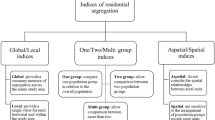Abstract
The aim of this paper is to propose a new location–allocation structure, in an effort to improve the operational shortcomings of the existing locations of primary health care centers. These shortcomings are mainly caused by the preference of patients to use local hospitals rather than health centers. The method is based on a biobjective mathematical programming model for locating hospitals and primary health care centers. Two objectives are considered: (1) minimization of distance between patients and facilities, (2) equitable distribution of the facilities among citizens. We formulate the model taking into consideration the interdependence of the locations i.e. the general hospitals and health centers. This approach enables us to introduce a new aspect to the location problem, namely public preferences and also to consider the decentralization of the health care system. In order to represent the available information we employ Geographic Information Systems (GIS). We apply this model in the area of Western Greece and then compare our results with the solution originally selected by planners. Demographic data concerning the major and minor population centers of the area were based on the latest census of 2001. The results confirm the necessity of applied scientific approaches for regulating the health care system in order to establish rational strategic planning and ensure the best use of the available resources.
Similar content being viewed by others
References
Collins CD, Green AT (1994) Decentralization and primary health care: some negative implications in developing countries. Int J Health Serv 24:459–476
Green BA, Naeem A, Ross D (2000) Resource allocation and budgetary mechanisms for decentralized health systems: experiences from Balochistan, Pakistan. Bull WHO 78:1024–1035
Berlin GN, ReVelle C, Elzinga J (1976) Determining ambulance-hospital locations for on-scene and hospital services. Environ Plann A 8:553–661
Calvo AB, Marks DH (1973) Location of health care facilities: an analytical approach. Socio-Econ Plann Sci 7:407–422
Verter V, Lapierre SD (2002) Location of preventive health care facilities. Ann Oper Res 110:123–132
Cheol-Joo C (1998) An equity–efficiency trade-off model for the optimum location of medical care facilitiess. Socio-Econ Plann Sci 32:99–112
Marianov V, Serra D (2002) Locations problems in the public sector. In: Drezner Z (ed) Facility location, a survey of applications and methods. Springer-Verlag
Pelletier C, Weil G (2003) Defining the regional healthcare planning objective using a multi-criteria approach. Logist Inf Manag 16:191–200
Sissouras A, Mitropoulos J, Gounaris C (2000) Evaluating the efficiency of health care units: the case of the greek health care centers. Proceedings of the 7th international conference on system science in health care, Budapest, Hungary, pp 202–205
Church RL, Eaton DJ (1987) Hierarchical location analysis using covering objectives. In: Ghosh A, Rushton G (ed) Spatial analysis and location–allocation models. Van Nostrand Reinhold, New York
Hodgson MJ (1988) An hierarchical location allocation model for primary health care in a developing area. Soc Sci Med 26:153–161
Narula SC (1984) Hierarchical location–allocation problems: a classification scheme. Eur J Oper Res 15:93–99
Moore G, ReVelle C (1982) The hierarchical service location problem. Manage Sci 28:775–780
Narula SC, Ogbu UI (1979) A hierarchical location–allocation problem. Omega 7:137–143
Galvão RD, Espejo LGA, Boffey TB (2002) A hierarchical model for the location of perinatal facilities in the Municipality of Rio de Janeiro. Eur J Oper Res 138:495–517
Narula SC (1986) Minisum hierarchical location–allocation problems in a network: a survey. Ann Oper Res 6:257–272
Adams EK, Wright GE (1991) Hospital choice of Medicare beneficiaries in a rural market: why not the closest? J Rural Health 7(2):134–152
Yip WC, Wang H, Liu Y (1998) Determinants of patient choice of medical provider: a case study in rural China. Health Policy Plan 3(3):311–322
Radcliff TA, Brasure M, Moscovice IS, Stensland JT (2003) Understanding rural hospital bypass behavior. J Rural Health 19(3):252–259
Mayhew L (1986) Urban hospital location. George Allen & Unwin, London
Serra D, ReVelle C (1993) The pq-median problem. Location and districting of hierarchical facilities. Location Sci 1:299–312
Mehrez A, Sinuany-Stern Z, Arad-Geva T, Binyamin S (1996) On the implementation of quantitative facility location models: the case of a hospital in rural region. J Oper Res Soc 47:612–625
Stummer C, Doerner K, Focke A, Heidenberger K (2004) Determining location and size of medical departments in a hospital network: a multiobjective decision support approach. Health Care Manage Sci 7:63–71
Chu S, Chu L (2000) A modeling framework for hospital location and service allocation. Int Trans Oper Res 7:539–568
Rahman SU, Smith DK (2000) Use of location–allocation models in health service development planning in developing nations. Eur J Oper Res 123:437–452
Sissouras A, Megaloconomos G (1980) Locations of rural health centers in Greece. Health services research and planning unit, University of Patras
Current J, Min H, Schilling D (1990) Multiobjective analysis of facility location decisions. Eur J Oper Res 49:295–307
Marsh M, Schilling D (1994) Equity measurement in facility location analysis: a review and framework. Eur J Oper Res 74:1–17
McGuirc GA, Porell FW (1984) Spatial patterns of hospital utilization: the impact of distance and time. Inquiry 21:84–95
Müller I, Smith T, Mellor S, Rare L, Genton B (1998) The effect of distance rom home on attendance at a small health centre in Papua New Guinea. Int J Epidemiol 27:878–884
Cohon J (1978) Multi-objective programming and planning. Academic Press, New York
Schultz GP (1970) The logic of health care facility planning. Socio-Econ Plann Sci 4:383–393
Author information
Authors and Affiliations
Corresponding author
Rights and permissions
About this article
Cite this article
Mitropoulos, P., Mitropoulos, I., Giannikos, I. et al. A biobjective model for the locational planning of hospitals and health centers. Health Care Manage Sci 9, 171–179 (2006). https://doi.org/10.1007/s10729-006-7664-9
Published:
Issue Date:
DOI: https://doi.org/10.1007/s10729-006-7664-9




